Blackjack is an exhilarating card game that has been thrilling players for centuries. The object of the game is simple: to get closer to 21 than the dealer without going over. Whether you’re a seasoned player or a novice, the fast-paced action of a blackjack table always keeps you on the edge of your seat.
Why should we learn and use strategy in blackjack? Well, playing blackjack is like a game of chess. You need to carefully plan your every move, anticipate your opponent’s moves and strategize accordingly to come out on top. It’s not just about luck, it’s about using your brainpower to outsmart the dealer. So, put your thinking cap on, trust your instincts, and let your strategy lead you to victory!
One of the most exciting aspects of blackjack is the element of strategy involved and utilizing charts for improved gameplay. Players must decide whether to hit, stand, double down, or split their cards. Each decision can make the difference between winning or losing and adds an extra level of excitement to the game.
Blackjack is not just a game of luck. It requires skill, strategy, knowledge about the charts, and the ability to think on your feet. It’s no wonder that it has become one of the most popular casino games in the world.
With each round, the tension builds as players hope for just the right card to bring them closer to their goal. They watch the dealer’s cards carefully, hoping to outsmart their opponents and win big.
So, whether you’re looking to challenge yourself, socialize, or just have some fun, blackjack is the game for you.
Blackjack is a game for all kind of gamblers
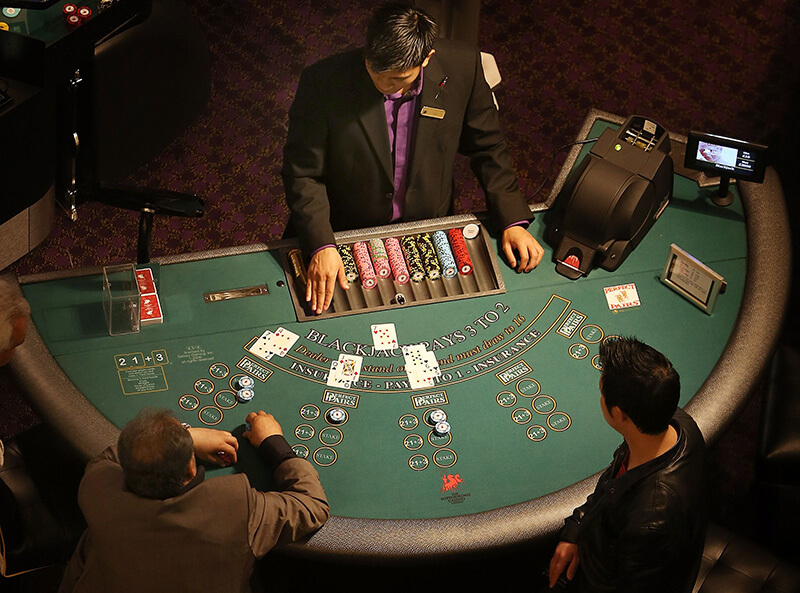
Basic blackjack gameplay
Here is a step-by-step basic blackjack gameplay, worth reviewing before going ahead (There may be some differences based on the version or terms applied by the casino):
1. The objective of the game is to beat the dealer’s hand without going over 21.
2. The dealer deals two cards to each player and two to themselves. One of the dealer’s cards is face-up and the other is face-down.
3. Cards 2-10 are worth their face value. Face cards (King, Queen, Jack) are worth 10 and Aces can be worth 1 or 11.
4. Players have the option to “hit” (take another card) or “stand” (keep their current hand) to get closer to 21.
5. If a player’s hand exceeds 21, they lose immediately and the dealer wins.
6. The dealer must hit until their hand has a value of at least 17.
7. If the dealer’s hand exceeds 21, any remaining players win.
8. If the player’s hand is closer to 21 than the dealer’s, they win their bet.
9. If the dealer’s hand is closer to 21 than the player’s, the dealer wins their bet.
10. If the player and dealer have the same hand value, it is a “push” and the player gets their bet back.
The fundamental principles and rules of playing blackjack
To join a blackjack table and relish the experience, all you need is a basic understanding and some practice to boost your confidence. This game is straightforward for novices to comprehend but offers ample opportunities for enhancement. At the outset of one’s blackjack expedition, attaining mastery of a basic blackjack strategy is a pivotal milestone.
The ultimate objective is to beat the house, and players can achieve this by acquiring more points than the dealer. However, there is a catch: the combined total cannot surpass 21. This predicament poses a challenge for players as they must decide whether to take another card in hopes of improving their hand or to stop and not risk going over the limit.
The responsibility of card handling lies with the dealer. Each player is dealt 2 cards, while the dealer’s card remains face down, putting the players at a slight disadvantage. In order to make decisions during the game, players only need to know a few key phrases.
- Hit/Stand: The initial two cards given to each participant are not the only cards available to them. Sometimes, it is advantageous to receive additional cards. To request another card, simply indicate by saying or clicking “Hit”. The dealer will then provide another card and await your next move. Once content with your hand, declare “Stand”.
- Double Down: The “Double Down” move is crucial to all blackjack versions. By doubling your bet, you’re doubling and requesting only one additional card. You can only make this move once after the first two cards have been dealt. If a player has already “hit” at least once, the Double Down move is no longer an option for that hand. Furthermore, it’s important to note that no additional cards can be drawn after the Double Down move is made. Hence, it’s advisable to proceed cautiously and make this call only when you’re entirely sure of your decision.
- Split Pairs: To split pairs, first ensure that two cards have an identical face value. You can then choose to divide your hand into two separate hands to be played individually, just like any other hand. You can still Hit, Stand, or Double, and sometimes you can even Split again.
After all, players have either accepted their hand or gone bust, and the dealer exposes their facedown card. In some game variations, the dealer’s entire hand is visible from the start, but to balance this out, less favorable rules are often introduced.
Is the perfect strategy for blackjack truly effective?
Playing blackjack involves a significant influence on player decisions, wherein effectively employing strategies can yield positive returns. Nonetheless, not all strategies will guarantee positive outcomes. As a beginner, it is essential to focus on one strategy that is proven based on sound mathematical principles, rather than relying on conjecture.
However remarkable a strategy may be, it cannot guarantee an average return exceeding 99.5%. The factor that allows some players to earn money playing blackjack is the possibility to count cards in brick-and-mortar casinos, gaining an advantage over the house. Card counters keep a watchful eye on every card dealt and are aware of shifts in winning and losing probabilities.
Blackjack strategy chart
To effectively play blackjack with optimal strategy, one option is to commit all possible game scenarios and decisions to memory. However, there exists a simpler solution. Familiarize yourself with a blackjack betting strategy sheet that comprehensively outlines actions to take in all possible situations. This method is user-friendly and suitable even for novice players to apply basic blackjack strategy. Additionally, the chart provides ample opportunity for easy memorization of the strategy.
How to read and use the basic blackjack strategy card?
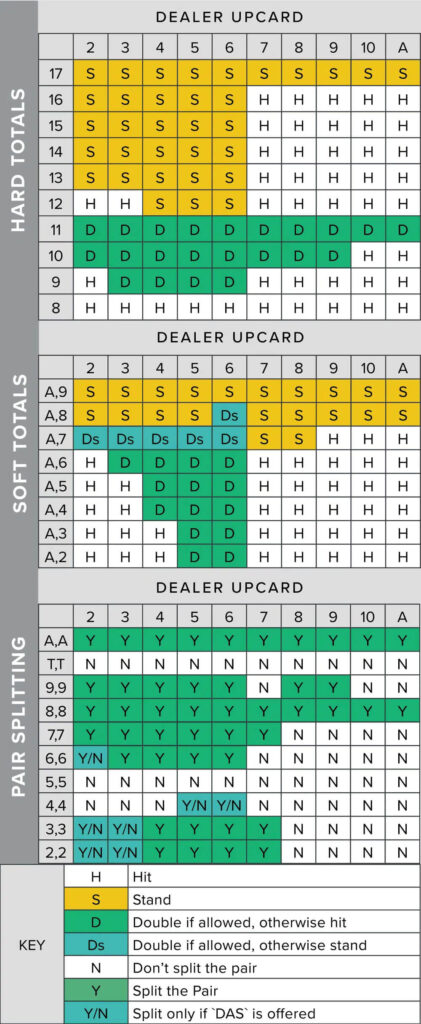
A blackjack strategy card is a tool used by players to improve their chances of winning in the game of blackjack. It is a small card that contains a chart or a table that outlines the recommended plays for every possible combination of the player’s cards and the dealer’s up card. The card is based on basic strategy and provides players with guidance on when to hit, stand, split, double down, or surrender. It is used as a reference and helps players make informed decisions quickly during a game. Using a strategy card can significantly improve a player’s chances of winning at blackjack and reduce the house edge.
One of the available versions of the blackjack strategy chart is presented below. There are various versions, but the content mostly remains the same while the presentation style differs. Given that different variants of blackjack have their own set of rules, the tables can have slight modifications to accommodate additional rules.
Users can easily find a dealer’s card in the upper section of the Blackjack Basic Strategy Table. On the left side, a player’s total is shown. By examining the top row, the dealer’s card value is determined, and by looking at the first vertical row, a player can find their total. By determining the intersection of the two points, the chart advises what action to take according to the Blackjack Strategy Chart. For example, if the dealer has a 7 and the player has 14, the chart indicates to Hit, abbreviated as “H,” at the intersection point.
Another instance could be when the dealer holds a 5 and the player has a hand of 12. This situation might be perplexing for the player since having a 12 is not considered as a strong hand and they might want to take another card, but the table instructs them to Stand. This is because the dealer is also at a disadvantage in this particular setup.
To further understand blackjack, it’s important to note a few additional things. A “Soft hand” is one which includes an Ace that can be valued at either 1 or 11 points, altering the strategy outlined in the blackjack chart. On the other hand, “Hard hands” do not contain an Ace and have a set value. Therefore, separate instructions will be provided in the blackjack guide chart based on whether you have a Soft or Hard hand.
Single deck blackjack
Although there are different versions of blackjack, the six-pack variety is the most popular. However, certain variations of the game are played with just one deck, as the quantity of cards in a shoe influences the optimal blackjack strategy. Despite utilizing a smaller number of cards, the rules for single-deck blackjack remain the same as those for multi-deck games. The primary difference lies in using a complete deck of 52 cards, which simplifies card tracking and decision-making.
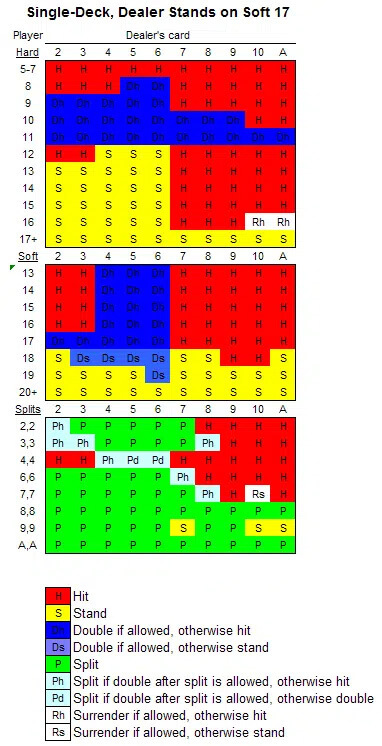
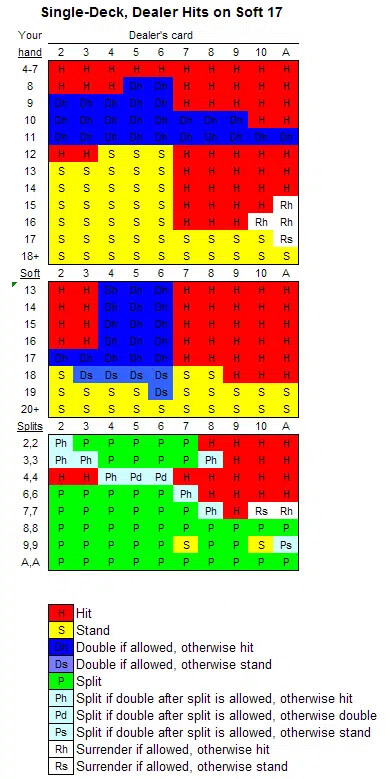
The chart functions in the same manner as explained previously, with the dealer’s card located at the top and the player’s hand at the left. While the majority of the six-deck chart corresponds with this one, there is a discrepancy regarding the appropriate action to take when a player holds 8 or 9 and the dealer has a hand lesser than 7. To achieve greater certainty, when playing with a single deck, instead of Hitting, players are advised to Double Down with an 8 when the dealer’s hand is 5 or 6.
4- to 8-deck blackjack
The chart typically employed is intended for games with multiple decks (4-8). It is crucial to note whether the dealer Stands/Hits on Soft 17, a rule that should be clearly stated in the chart’s description. This rule determines how situations are handled when the dealer holds an Ace against a player’s 15 and 17. With a Stand on Soft 17 rule, players are advised to surrender if feasible, since the odds of the dealer besting the player are greater when the opposite is true.
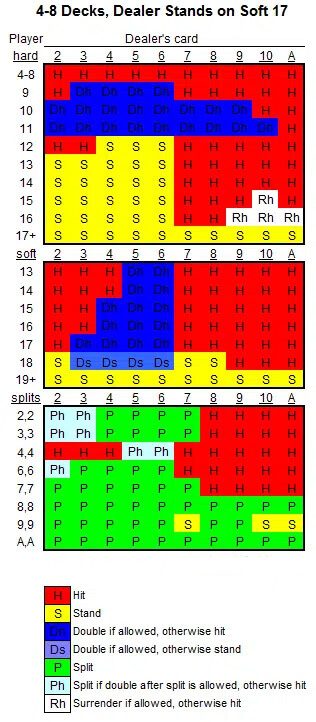
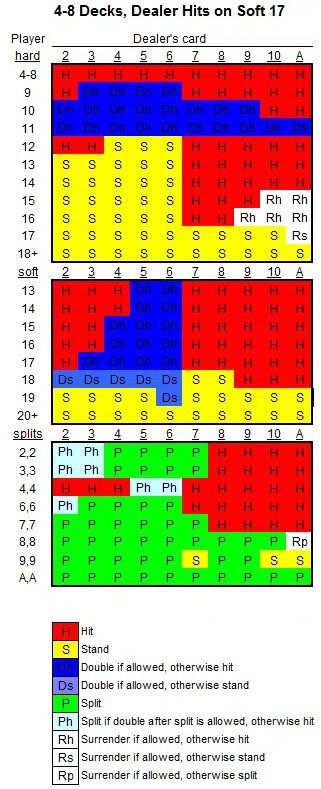
There are more advanced charts that incorporate multiple scenarios. They provide guidance on whether to surrender, split, or double down, as well as what to do in situations where those options are not available. As an example, the chart depicted below includes the instruction to either surrender or hit when playing with Rh. In blackjack, surrendering enables players to withdraw from the game if the odds are not in their favor.
With an RTP of 99.62%, players may be deterred by the 50% bet cost to escape unfavorable scenarios. However, it’s important to note that the surrender option is only offered after two initial cards have been dealt with. This means that although it may seem disheartening, it’s possible to better the hand before considering yielding. In certain instances, it may be wise to salvage at least half of the wager.
What is the blackjack basic strategy?
Reliance on intuition may not yield the most advantageous outcomes in blackjack decision-making. Despite feeling confident in one’s choices, this approach ultimately incurs losses. On the contrary, utilizing a blackjack strategy chart enables informed and objective decisions based on mathematical calculations. Implementing this tactic optimizes players’ RTP and effectively diminishes the house edge.
At its core, the Blackjack strategy is straightforward and efficient, encompassing all possible scenarios. It generally appears in a tabular format. After mastering its usage, memorization becomes unnecessary.
When can I/should I surrender in blackjack?
The blackjack decision table offers players the excellent choice of quitting. It’s advised that players surrender if they have a total of 15 and 16, and the dealer has a high card (9, 10, or A). Furthermore, if the dealer hits on Soft 17, players should surrender if they have 17. A useful reference for this is the surrender recommendation on the table, which is represented by the letter R.
When can I/should I split in blackjack?
Splitting instructions are commonly displayed in a dedicated chart as there exist numerous rules regarding splitting, making it more practical to refer to the table than to commit them to memory. It is worth noting that these rules can slightly differ depending on whether the dealer Hits or Stands on Soft 17, and since there are different variations of blackjack, it is essential to recognize that whenever Rh is seen, it signifies Surrender, and if it is not permissible, Hit. Additionally, Rs represents Surrender or Stand, and Rp is indicative of Surrender or Split.
When can I/should I double in blackjack?
Sophisticated basic strategy tables include varying rules for doubling, all of which are covered. The table on this page denotes Dh and Ds as Double or Hit and Double or Stand, respectively. This signifies that if doubling is not an option, the alternative is to hit or stand.
Should I hit or should I stand concepts explained
The concepts of Hitting and Standing are uncomplicated. H refers to Hit while S indicates Stand. Refer to the table to determine the appropriate action to take. When facing a dealer’s high-value card with a low-value hand, it is usually preferable to take the Hit option.
Advanced Blackjack Strategy
The simplified blackjack strategy is designed for convenience and ease of memory, but it may overlook certain scenarios that require advanced tactics. Nonetheless, it’s a fantastic resource for most blackjack enthusiasts. Aspiring pros seeking a higher level of expertise, however, ought to explore the more complex yet more precise advanced blackjack strategy table.
Blackjack guide
One of the primary distinctions is that the basic strategy takes into account the cards held by the player. For example, if the dealer has 10 and the player holds 15, basic blackjack strategy would advise hitting. However, it does not factor in the specific numbers and values of the cards in the hand. If the hand consists of low-value cards such as 5, 4, 3, and 3, the chances of going bust are higher as there are fewer winning cards available. Advanced strategy, on the other hand, recommends standing in this scenario. Other differences between basic and advanced strategies are discussed below.
- The treatment of insurance differs in advanced blackjack strategy, despite it being considered a bad move in the standard play chart. Experienced card counters recognize a few exceptions to this rule, particularly when dealing with a favorable deck. A deck is considered favorable when there are more low-value cards (2-6) remaining than high-value cards (worth 10), and card counters add a point to their count every time a low-value card is dealt. When the count reaches +4 or higher, it is wise to take insurance against the dealer’s Ace since the likelihood of a face-down 10-value card increases.
- Advanced players who count cards may make a move that goes against the conventional blackjack basic chart. In cases where a pair of 10s is dealt with, the general advice is to Stand. However, if card counters are aware that the deck has many 10s, they may choose to Split instead when facing a dealer with a 5 or 6. This is because the dealer has a higher chance of going Bust in this scenario.
Once you have mastered the basics, there are additional differences to discover between basic and advanced blackjack strategies. There are numerous complexities to delve into.
How to learn these blackjack strategies?
Learning numerous rules as a beginner player can be daunting. To simplify matters, familiarize yourself with a fundamental strategy table and refer to it for guidance. Gradually, most rules will become natural to you. An excellent choice is to practice playing
Tips for memorizing
There are certain tactics that aid in the memorization of blackjack charts. One such method involves examining the table and commencing with the rows that suggest identical actions. For instance, when a player has 4-8, irrespective of the dealer’s hand, you should consistently Hit. Similarly, when the player has a 17 or higher, one should always Stand. By adopting this approach, you can effortlessly recollect a portion of the strategy.
An alternative approach is to commit each line to memory. For example, if players have a difficult 9 hand, they should Hit when the dealer has a 2 or 7 and Double down when the dealer has a 3 to 6. It’s simpler to remember lines individually instead of attempting to memorize all of the rules simultaneously.
Utilize software specifically created to educate blackjack players about basic strategy for practice. Unlike standard demo modes offered by online casinos, these programs provide feedback on the accuracy of your decision-making.
How to use blackjack charts?
When starting out, following the fundamental strategy is the most beneficial approach. Despite any instinctual hunches, all choices should align with this method. Adhering to its prescribed guidelines lessens the potential for the house edge. Straying from these rules gradually weakens the efficacy of the strategy.
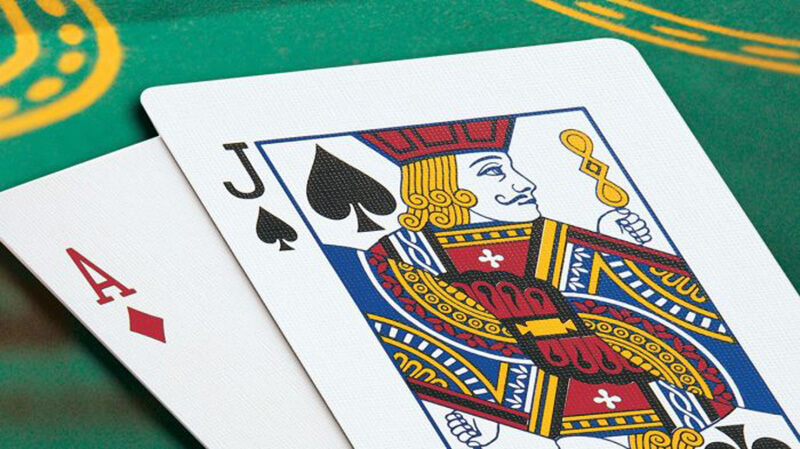
If you enjoy playing blackjack and want to extend your deposit, claiming bonuses may be a tempting option. Unfortunately, this game isn’t the best choice when it comes to bonus offers. The issue lies in the fact that blackjack typically doesn’t count towards the necessary wagering requirements to clear bonus credits, rendering them useless unless you use them for slot wagers instead.
- Select a Betting Approach that Matches Your Finances. Be aware that both the simplest and most complex strategies do not yield miraculous outcomes. As with any other gambler, you will experience both victories and losses. Even if it is the ideal formula, it does not guarantee a win. Therefore, be prepared for setbacks and establish an appropriate budget. Determine beforehand the total amount to allocate per round and per session.
- The notion of using a single strategy for all blackjack variants is a flawed one. Numerous versions of the game necessitate minor modifications in basic strategy. Having a one-size-fits-all approach isn’t effective. Individual basic strategies are necessary for single-deck and multi-deck variants. Moreover, players should pay attention to the “Hit or Stand” rule when dealers encounter Soft 17. Hence, it’s crucial to exercise care and scrutinize the basic strategy chart being used.
- It is crucial to memorize the strategy when playing offline to avoid being the one who slows down the game. However, for online blackjack, memorization is not obligatory as a chart can be used as a guide. Nonetheless, recalling everything is still ideal for swift gameplay.
Why follow a blackjack decision table?
The reason for its effectiveness is that it increases your average winning rate. In contrast, other approaches like Martingale, rely on chance rather than arithmetic. While Martingale is a prevalent strategy in both roulette and blackjack, it does not enhance the probability of winning and actually raises the potential for losing your funds.
The essential advantage of utilizing the basic blackjack strategy is achieving the highest potential theoretical RTP while barely giving the house an edge of only 0.5%. This is an incredibly low percentage in the realm of gambling. However, the main drawback is that some individuals may not enjoy adhering to rigid regulations and not being able to make personal choices that can impact the result. Though the overall payback rate may be greater, for certain players, it can be less enjoyable.
Blackjack strategy FAQ
To be honest, learning blackjack professionally needs attention and practice. So, if you feel too lazy about it, then as a suggestion, you may find your way by focusing to boost your luck in gambling using Chinese Feng Shui! Moreover, keep in mind to always play responsibly, here is a basic guide on: how to quit problem gambling?
The followings are the most common and frequently asked questions about the blackjack strategy:
Does the blackjack strategy really work?
Undeniably, utilizing this technique can undoubtedly enhance your performance and ensure optimal returns for players over a long period. Originally introduced in 1956, it has undergone development and refinement through the efforts of various mathematicians who have consequently put it to the test. It is important to note, however, that its success is not always guaranteed as short-term losses may occur. Thus, there may be moments when you may feel tempted to abandon this particular blackjack betting method. Despite such doubts, it is recommended that you trust this strategy for maximum gain in the long run.
Why are there multiple blackjack strategy charts?
As the game rules shift, the strategy must also be adjusted accordingly, which is why multiple chart options are often available. To determine the appropriate choice, two key questions should be considered: whether the dealer Hits or Stands on Soft 17 and the number of decks in play. To cater to these variables, we have developed four charts: two for single-deck games that have Hit/Stand on Soft 17, and two for blackjack games featuring 4-8 decks. These are the most commonly used options. Ideally, the strategy would differ with each additional deck, when playing with 4-8 decks, but, the variance in strategy is minor and can therefore be disregarded.
Is it important to play blackjack exactly as it’s described in the strategy?
Indeed, if you want to achieve optimal results, it is crucial to stick to the blackjack strategy once you have chosen to use it. However, if you are playing for leisure and do not find following rules enjoyable, you may occasionally deviate from the strategy without expecting a significant increase in payouts. Nevertheless, if your objective is to maximize your returns, it is essential to fully grasp the strategy and never stray from it, even if you believe certain hands could be played differently. This necessitates discipline, perseverance, and a substantial amount of trust; questioning the strategy halfway through the game is not an option.
Final thoughts
In conclusion, learning and using the blackjack strategy can provide a lot of benefits for players, both in the short and long term. It can help you reduce the house edge, make smarter decisions, and manage your bankroll more effectively. By taking the time to learn these strategies, you can improve your chances of winning and maximize your profitability.
Additionally, following a blackjack strategy can also enhance your overall gaming experience, as it can add an element of skill and strategy to your gameplay.
So, if you are serious about playing blackjack and want to increase your chances of winning, then learning and implementing a solid strategy is definitely worth the effort.
blackjack strategy – Leylaj Magazine

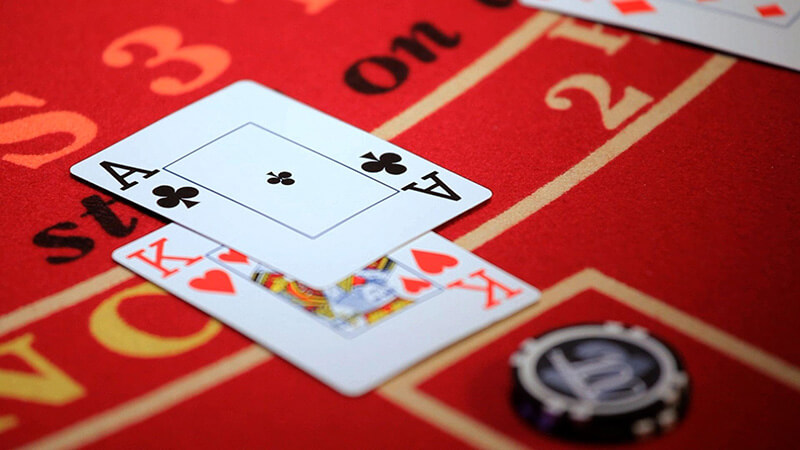
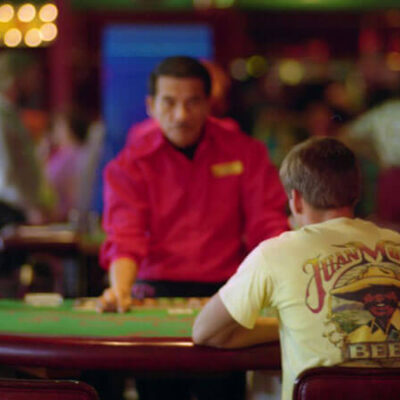
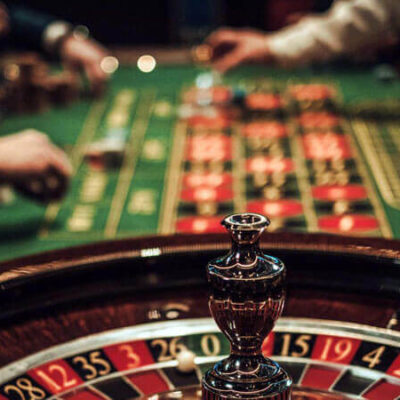
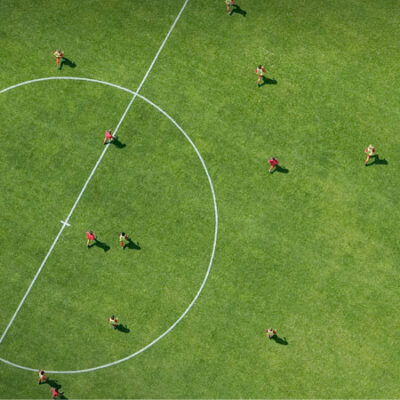
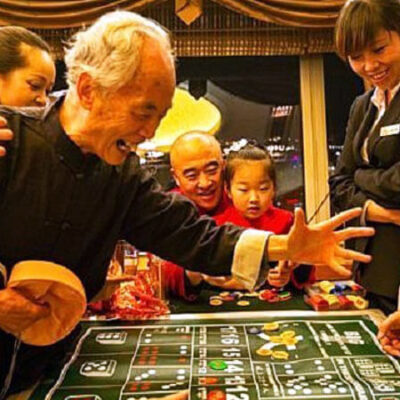
2 Comments